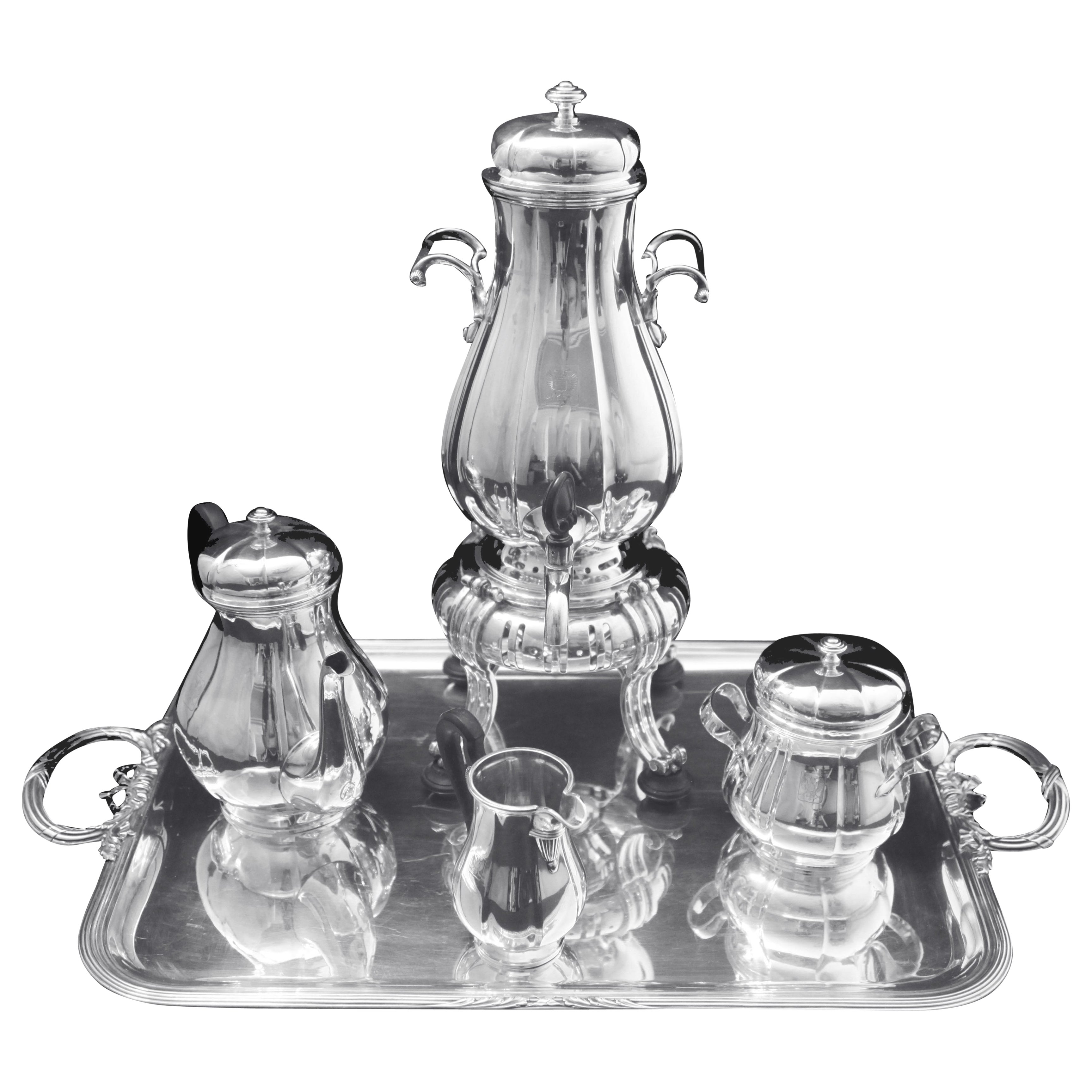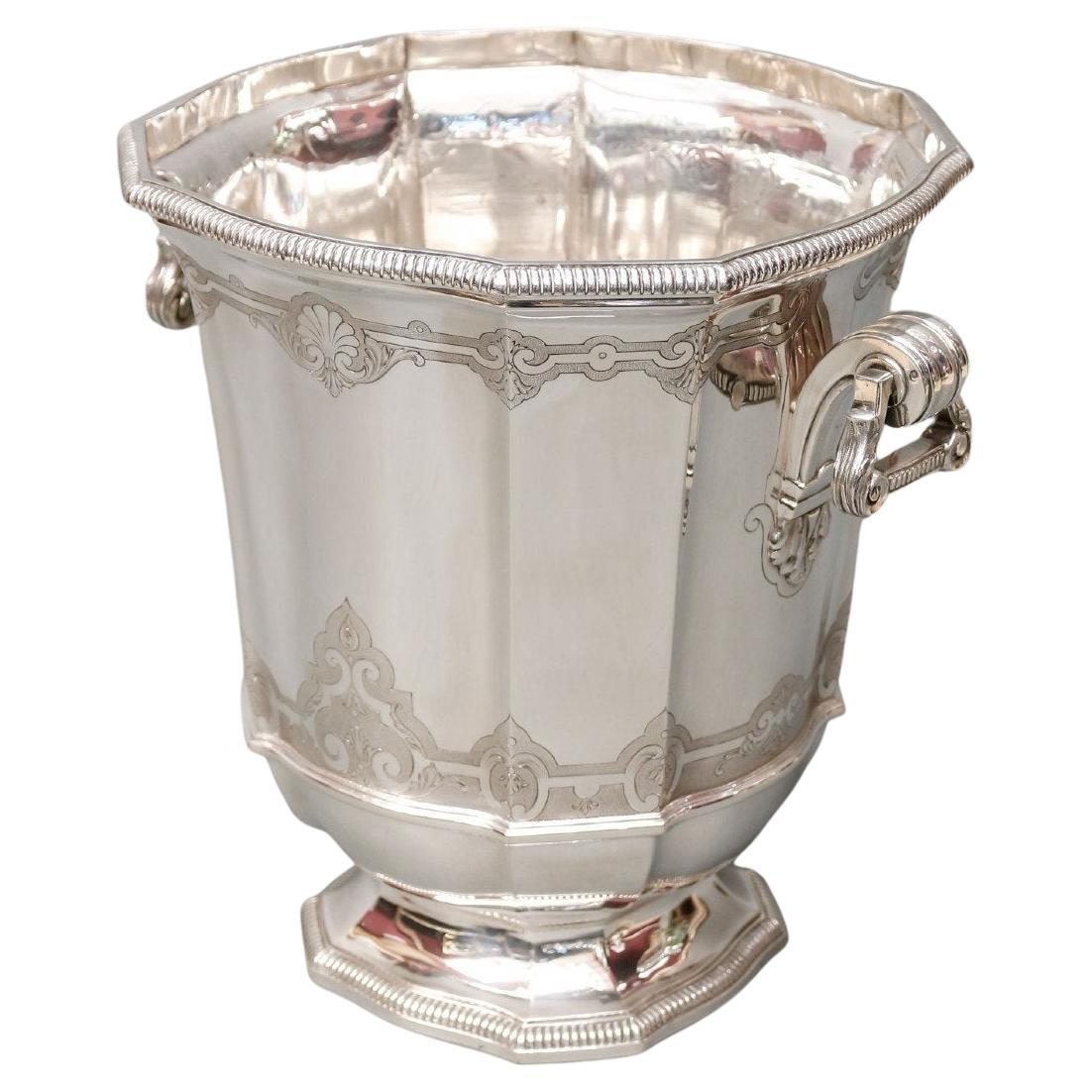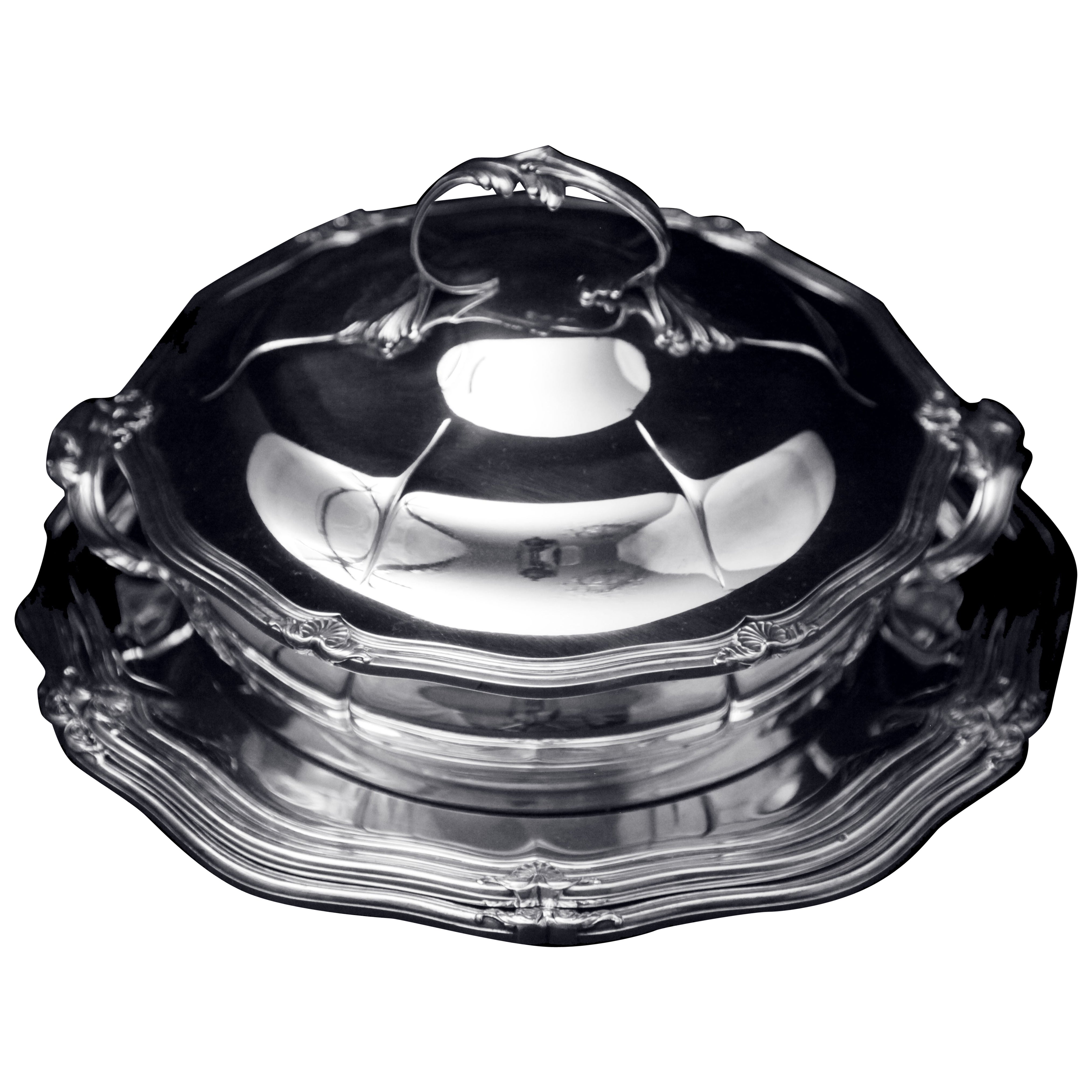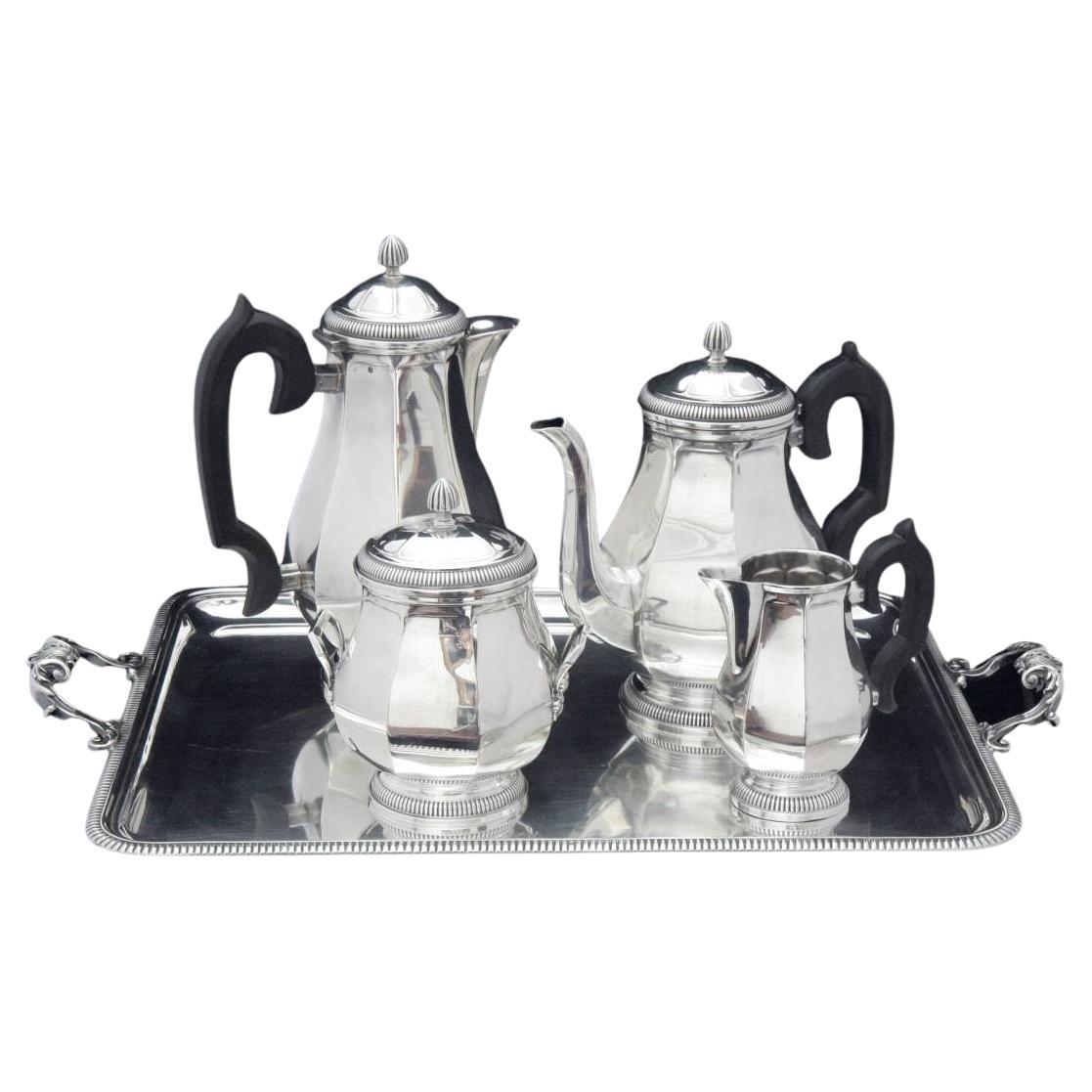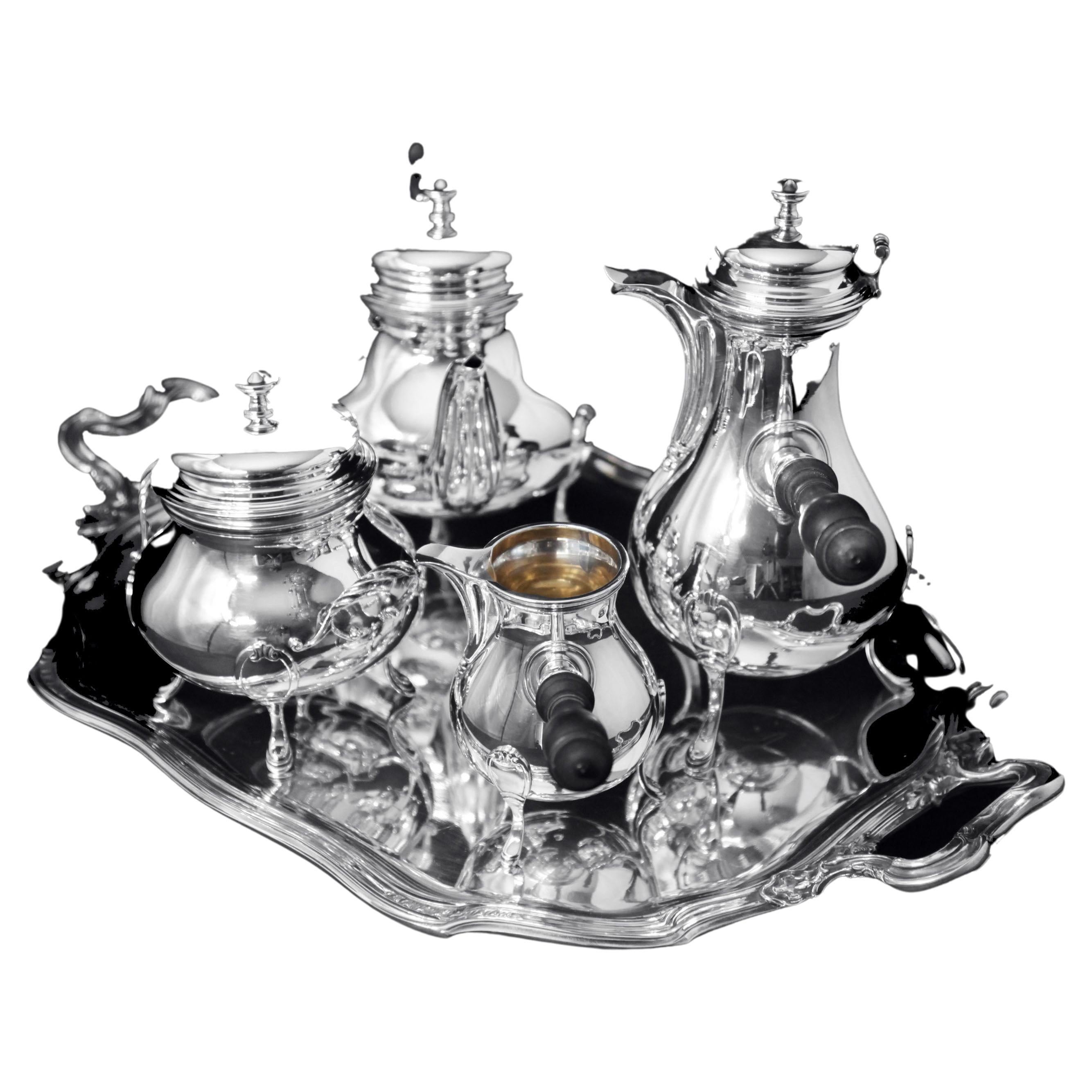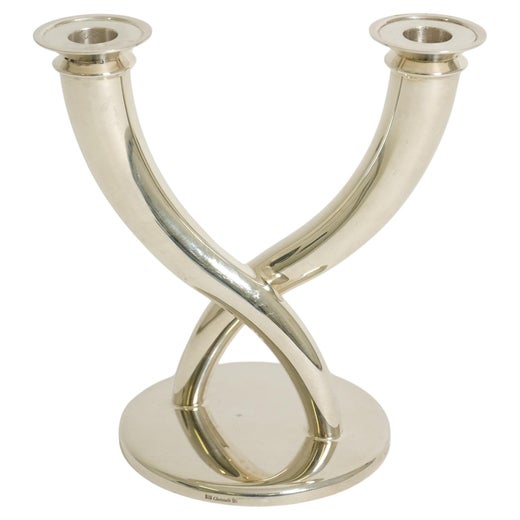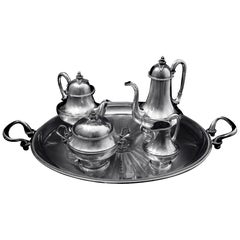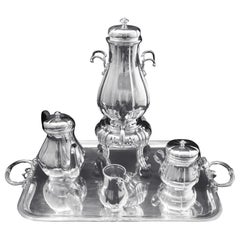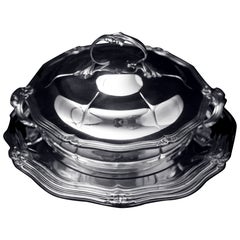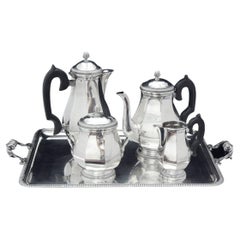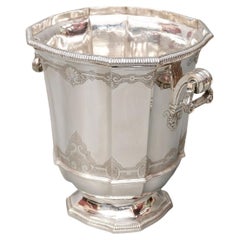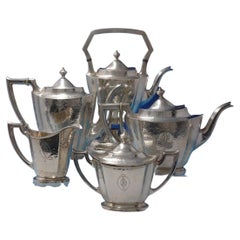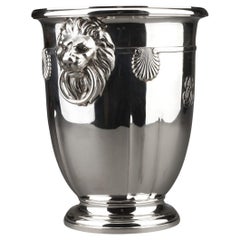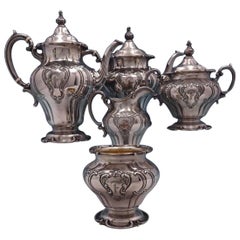Direct from Paris, a magnificent 5pc., original French Art Deco 950 sterling silver tea set by French silversmiths “Ernst Prost” and “Olier & Caron” in superb condition and includes 5 anti-tarnish storage wraps for easy storage – circa early 1900s. The world of silversmithing has long been synonymous with elegance, craftsmanship, and luxury. Throughout history, certain artisans have stood out as true masters of their craft, combining artistic vision with technical expertise to create timeless works of art. Among these luminaries is Ernst Prost, a French silversmith whose legacy is defined by extraordinary craftsmanship, royal patronage, prestigious accolades, and a body of work that bridges tradition and modernity. His most celebrated creations, particularly his exquisite Art Deco 950 sterling silver tea sets, embody the refinement and innovation that made him one of the foremost silversmiths of his time.
Ernst Prost was born into a family of craftsmen in the late 19th century, at a time when French silversmithing was undergoing a period of great transformation. Prost's early exposure to the craft, combined with formal training under some of the leading silversmiths of the time, laid the foundation for his career. From a young age, Prost exhibited a natural talent for working with silver, and he quickly developed a reputation for his meticulous attention to detail and his innovative approach to design. After completing his apprenticeship, Prost established his own workshop in Paris, where he began producing silver objects that were marked by their precision and artistic flair. His early work adhered to the classical styles that had dominated French silversmithing for centuries, but Prost was also eager to experiment with new forms and techniques. As his career progressed, Prost increasingly embraced the modernist aesthetics of the Art Deco movement, which would come to define much of his later work.
Prost’s work is distinguished by a number of key characteristics that set it apart from that of his contemporaries. First and foremost, Prost was known for the exceptional quality of his craftsmanship. Every piece that came out of his workshop was a testament to his technical skill and his dedication to perfection. Prost was a master of traditional silversmithing techniques, including hand-hammering, engraving, and repoussé. He also pioneered new methods, experimenting with different finishes and textures to enhance the visual and tactile qualities of his work. Prost's attention to detail extended to every aspect of his creations, from the overall design to the smallest decorative elements. His pieces were meticulously planned and executed, often featuring intricate engravings, geometric patterns, and floral motifs. Prost had a particular talent for integrating form and function, ensuring that even his most elaborate pieces were practical and easy to use.
By the early 20th century, the Art Deco movement had begun to sweep across Europe, influencing everything from architecture to fashion to industrial design. Characterized by its emphasis on geometric shapes, clean lines, and bold decorative elements, Art Deco represented a departure from the ornate, flowing forms of the Art Nouveau movement that preceded it. Instead, Art Deco embraced modernity, celebrating technology and innovation while still retaining a sense of luxury and elegance. Ernst Prost was profoundly influenced by the Art Deco movement, and many of his most celebrated works reflect its aesthetic principles. Prost's Art Deco silver pieces are marked by their bold geometric forms, streamlined designs, and the use of strong, symmetrical patterns. His tea sets, in particular, embody the elegance and simplicity that are hallmarks of the Art Deco style. Prost’s Art Deco tea sets often featured angular, stepped designs, with handles and spouts that mirrored the sharp, geometric lines of the overall composition. The surfaces of these tea sets were typically polished to a high sheen, creating a striking contrast with the engraved or embossed decorative elements. Prost also made extensive use of natural motifs in his Art Deco designs, incorporating stylized representations of flowers, leaves, and animals into his silverwork. These decorative elements were often rendered in a highly stylized, almost abstract manner, in keeping with the Art Deco aesthetic.
One of the most notable features of Prost’s Art Deco tea sets is the way in which they balance form and function. While the designs are undeniably modern and avant-garde, they are also practical and user-friendly. Prost paid careful attention to the ergonomics of his tea sets, ensuring that the handles were comfortable to hold, the spouts poured smoothly, and the lids fit securely. This combination of beauty and functionality is one of the reasons why Prost’s tea sets remain so highly prized by collectors and connoisseurs. These tea sets are celebrated not only for their striking beauty but also for their durability and practicality. Crafted from the finest 950 sterling silver, Prost’s tea sets are known for their radiant finish and exceptional craftsmanship. Prost’s tea sets were also notable for their balanced proportions and ergonomic design. The handles of the teapots and cups were designed to be both aesthetically pleasing and comfortable to use, while the spouts were carefully engineered to ensure a smooth, drip-free pour. Even the smallest details, such as the finials on the lids and the hinges on the sugar bowls, were meticulously crafted to ensure both functionality and beauty.
Ernst Prost's exceptional craftsmanship and innovative designs did not go unnoticed by the elite of his time. His work soon attracted the attention of European royalty, who were always on the lookout for the finest artisans to create luxurious objects for their homes and palaces. Prost’s reputation as a master silversmith made him a natural choice for royal commissions, and he quickly established himself as a favorite among the nobility. Prost's relationship with royalty was one of mutual admiration. The French royal family, in particular, became frequent patrons of his work, commissioning everything from elaborate tableware sets to ceremonial objects. Prost’s ability to combine traditional silversmithing techniques with modern Art Deco design made him particularly well-suited to creating pieces that were both functional and symbolic of royal power and prestige. One of Prost’s most notable commissions came from King George V of England, who requested an Art Deco tea set for his private collection. This commission was a significant honor for Prost, as it demonstrated that his work had gained international recognition and was sought after by some of the most discerning clients in the world. The tea set Prost created for King George was a masterpiece of Art Deco design, featuring sleek geometric forms, elegant engravings, and the finest 950 sterling silver.
Ernst Prost’s career was marked by numerous awards and accolades, reflecting both the quality of his craftsmanship and the innovative nature of his designs. His participation in international exhibitions allowed him to showcase his work to a global audience, and his Art Deco tea sets, in particular, were frequently singled out for praise. One of the highlights of Prost’s career came in 1925, when he exhibited at the International Exhibition of Modern Decorative and Industrial Arts in Paris, the event that is widely credited with popularizing the Art Deco movement. Prost’s work was displayed alongside that of other leading silversmiths, but it was his tea sets that garnered the most attention. The judges were particularly impressed by the way Prost had managed to incorporate the bold, geometric forms of Art Deco into functional objects, and he was awarded a grand prize for his contributions to the exhibition. In addition to his royal patrons, Prost’s work was also sought after by wealthy collectors and connoisseurs around the world. His tea sets and other silver objects became status symbols for those who could afford them, and owning a piece by Prost was seen as a mark of refined taste and sophistication.
Ernst Prost’s impact on the world of silversmithing and decorative arts extends far beyond his own lifetime. His work set a new standard for quality and craftsmanship, and his innovative designs helped to define the aesthetic of the Art Deco movement. Prost’s ability to blend traditional silversmithing techniques with modern design principles ensured that his work remained relevant and influential even as tastes and trends changed. Prost’s legacy is also reflected in the many artisans he trained and mentored over the course of his career. His workshop in Paris became a center of excellence for silversmithing, attracting young craftsmen from across Europe who sought to learn from the master. Many of Prost’s apprentices went on to become successful silversmiths in their own right, carrying forward the techniques and principles that Prost had instilled in them.
Today, Ernst Prost is remembered as one of the greatest silversmiths of the Art Deco era, and his work continues to be admired by collectors, museums, and connoisseurs around the world. His Art Deco tea sets in particular, like this amazing 4 piece set, remain highly sought after for their beauty, craftsmanship, and historical significance. Prost’s creations can be found in some of the most prestigious collections, including the Louvre in Paris, the Victoria and Albert Museum in London, and the Metropolitan Museum of Art in New York.
This amazing 950
sterling silver art deco tea set...

